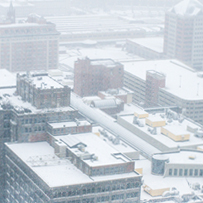
It’s January and whether we like it or not winter is here! If you live in a cold climate, GenFlex’s Ben George, Technical Building Solutions Manager, has some tips to help protect your roof this winter. He recommends inspections and maintenance, removal of excessive snow, and proper removal of ice accumulations.
Inspection and Maintenance
Establishing a regular inspection and maintenance program with a GenFlex contractor is highly recommended. The National Roofing Contractors Association (NRCA) suggests at least two visits annually, usually one before winter and another in the spring. Work with your GenFlex contractor to identify and repair areas of concern and perform routine maintenance to prevent leaks and preserve existing warranty coverage. Ensure drainage components such as roof drains, gutters, downspouts, and roof scuppers are free and clear to promote positive drainage.
Snow Loads
Depending on the building’s construction and winter weather conditions, excess snow loads may need to be removed to reduce the risk of structural damage or even a total roof collapse.
It is a good idea to mark the locations of drains, skylights, and other low-profile components on a roof before the snow flies. Consider using driveway markers. There are also markers specifically designed for roof drains on the market. The installation of skylight screens or guardrails should also be considered.
If rooftop snow removal is necessary, it is recommended that you contact a professional such as your GenFlex roofing contractor to do the job. However, when using your own team keep in mind the following:
- Always take the proper safety precautions. Accessing the roof in winter conditions can be extremely hazardous.
- Never use—or allow others to use—equipment that will damage the roof system. Damage caused by snow blowers, for example, can be catastrophic.
Ice Accumulation
Ice accumulation that occurs as a result of snow melting in the daytime and re-freezing at night can also cause roof damage, and poses serious fall hazards. Do not attempt to break up dams or sheets of ice, as doing so will likely damage the roof. If necessary, calcium chloride can be used to melt the ice. It generally poses less risk to roofing materials than conventional rock salt.
Finally, mark Monday, March 20, 2017, on your calendar. That’s the first day of spring. Hang in in there, it’s only a couple of months away. In the meantime, if you need any assistance with your roof this winter contact GenFlex or locate a GenFlex-authorized contractor here.
